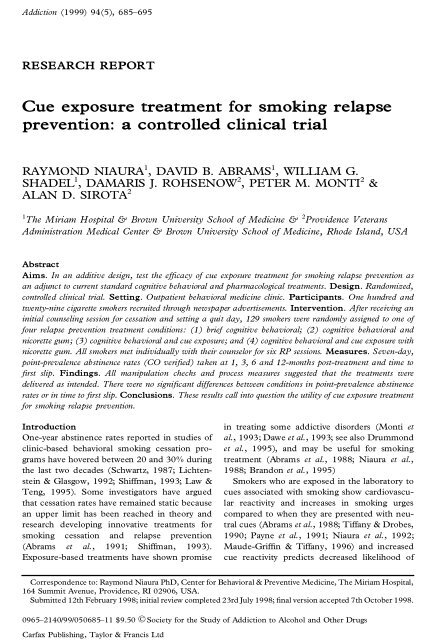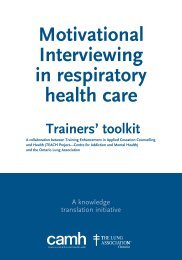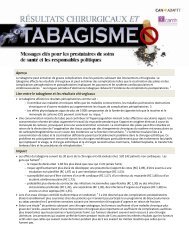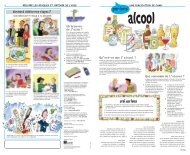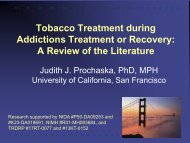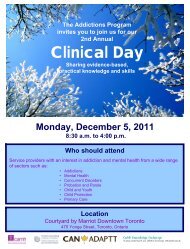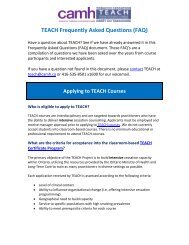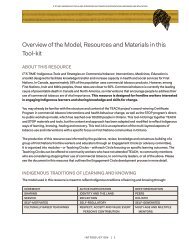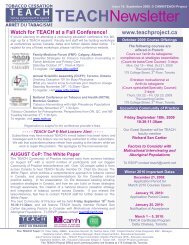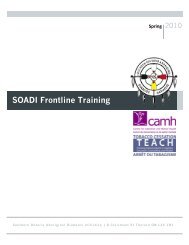Cue exposure treatment for smoking relapse prevention - CAMH ...
Cue exposure treatment for smoking relapse prevention - CAMH ...
Cue exposure treatment for smoking relapse prevention - CAMH ...
You also want an ePaper? Increase the reach of your titles
YUMPU automatically turns print PDFs into web optimized ePapers that Google loves.
Carfax Publishing, Taylor & Francis LtdAddiction (1999) 94(5), 685± 695RESEARCH REPORT<strong>Cue</strong> <strong>exposure</strong> <strong>treatment</strong> <strong>for</strong> <strong>smoking</strong> <strong>relapse</strong><strong>prevention</strong>: a controlled clinical trialRAYMOND NIAURA 1 , DAVID B. ABRAMS 1 , WILLIAM G.SHADEL 1 , DAMARIS J. ROHSENOW 2 , PETER M. MONTI 2 &ALAN D. SIROTA 21 The Miriam Hospital & Brown University School of Medicine & 2 Providence VeteransAdministration Medical Center & Brown University School of Medicine, Rhode Island, USAAbstractAims. In an additive design, test the ef® cacy of cue <strong>exposure</strong> <strong>treatment</strong> <strong>for</strong> <strong>smoking</strong> <strong>relapse</strong> <strong>prevention</strong> asan adjunct to current standard cognitive behavioral and pharmacological <strong>treatment</strong>s. Design. Randomized,controlled clinical trial. Setting. Outpatient behavioral medicine clinic. Participants. One hundred andtwenty-nine cigarette smokers recruited through newspaper advertisements. Intervention. After receiving aninitial counseling session <strong>for</strong> cessation and setting a quit day, 129 smokers were randomly assigned to one offour <strong>relapse</strong> <strong>prevention</strong> <strong>treatment</strong> conditions: (1) brief cognitive behavioral; (2) cognitive behavioral andnicorette gum; (3) cognitive behavioral and cue <strong>exposure</strong>; and (4) cognitive behavioral and cue <strong>exposure</strong> withnicorette gum. All smokers met individually with their counselor <strong>for</strong> six RP sessions. Measures. Seven-day,point-prevalence abstinence rates (CO veri® ed) taken at 1, 3, 6 and 12-months post-<strong>treatment</strong> and time to® rst slip. Findings. All manipulation checks and process measures suggested that the <strong>treatment</strong>s weredelivered as intended. There were no signi® cant differences between conditions in point-prevalence abstinencerates or in time to ® rst slip. Conclusions. These results call into question the utility of cue <strong>exposure</strong> <strong>treatment</strong><strong>for</strong> <strong>smoking</strong> <strong>relapse</strong> <strong>prevention</strong>.IntroductionOne-year abstinence rates reported in studies ofclinic-based behavioral <strong>smoking</strong> cessation programshave hovered between 20 and 30% duringthe last two decades (Schwartz, 1987; Lichtenstein& Glasgow, 1992; Shiffman, 1993; Law &Teng, 1995). Some investigators have arguedthat cessation rates have remained static becausean upper limit has been reached in theory andresearch developing innovative <strong>treatment</strong>s <strong>for</strong><strong>smoking</strong> cessation and <strong>relapse</strong> <strong>prevention</strong>(Abrams et al., 1991; Shiffman, 1993).Exposure-based <strong>treatment</strong>s have shown promisein treating some addictive disorders (Monti etal., 1993; Dawe et al., 1993; see also Drummondet al., 1995), and may be useful <strong>for</strong> <strong>smoking</strong><strong>treatment</strong> (Abrams et al., 1988; Niaura et al.,1988; Brandon et al., 1995)Smokers who are exposed in the laboratory tocues associated with <strong>smoking</strong> show cardiovascularreactivity and increases in <strong>smoking</strong> urgescompared to when they are presented with neutralcues (Abrams et al., 1988; Tiffany & Drobes,1990; Payne et al., 1991; Niaura et al., 1992;Maude-Grif® n & Tiffany, 1996) and increasedcue reactivity predicts decreased likelihood ofCorrespondence to: Raymond Niaura PhD, Center <strong>for</strong> Behavioral & Preventive Medicine, The Miriam Hospital,164 Summit Avenue, Providence, RI 02906, USA.Submitted 12th February 1998; initial review completed 23rd July 1998; ® nal version accepted 7th October 1998.0965± 2140/99/050685± 11 $9.50 Ó Society <strong>for</strong> the Study of Addiction to Alcohol and Other Drugs
<strong>Cue</strong> <strong>exposure</strong> <strong>treatment</strong> and <strong>smoking</strong> 687them to quit <strong>smoking</strong> (brief cessation <strong>treatment</strong>),then to test whether different <strong>relapse</strong> <strong>prevention</strong>programs had differential ef® cacy in preventing<strong>relapse</strong> (<strong>relapse</strong> <strong>prevention</strong> condition). Thus, allsubjects received the same program to help themquit, but received different programs to helpwith preventing <strong>relapse</strong>.Subjects scheduled their target quit day(TQD) 1 week after the brief cessation <strong>treatment</strong>session. The TQD marked the start of subjects’assigned <strong>relapse</strong> <strong>prevention</strong> condition <strong>treatment</strong>.Regardless of the <strong>relapse</strong> <strong>prevention</strong> condition towhich subjects were assigned, all sessions werescheduled twice during <strong>for</strong> the same week as thequit day, and three more times during the followingweek. Sessions could extend into a fourthweek if scheduling dif® culties precluded completionof <strong>treatment</strong> within the ® rst three weeks.Thus, the <strong>relapse</strong> <strong>prevention</strong> sessions wereequated on number of sessions in order to control<strong>for</strong> the effects of contact time on <strong>treatment</strong>outcome. Follow-up telephone interviews wereconducted 1, 3, 6 and 12 months following theend of <strong>treatment</strong>.Brief cessation <strong>treatment</strong> session. All subjectssigned in<strong>for</strong>med consent and completed a baselineassessment battery, which included theSmoking Triggers Interview (STI). The STI is apersonalized hierarchy of high-risk-<strong>for</strong>-<strong>relapse</strong><strong>smoking</strong> situations that is generated by askingsubjects to identify <strong>smoking</strong> triggers: situationsor events which were accompanied by intenseurges to smoke and diminished ef® cacy to resist<strong>smoking</strong>. Subjects were asked to recall and rateat least six situations on 11-point scales (1 5 notat all; 11 5 extremely) assessing levels of <strong>smoking</strong>urge and self-ef® cacy to resist <strong>smoking</strong> urges.The situations were then rank ordered accordingto most intense urge and least ef® cacy at resisting<strong>smoking</strong> urges. Subjects were encouraged toprovide details about visual, environmental andolfactory cues, as well as thoughts and feelingsaccompanying each situation.All subjects were given the American LungAssociation (ALA) self-help manual, Freedomfrom Smoking <strong>for</strong> You and Your Family. A COreading was obtained (Ecolyzer, NationalDraeger, Inc.), and feedback was provided to thesubject. The therapist reviewed the subject’s<strong>smoking</strong> and quitting history, reasons <strong>for</strong> <strong>smoking</strong>and wanting to quit and rein<strong>for</strong>ced his or hercommitment to quit. Smoking was presented asboth a learned habit and a physical addiction. Inaddition, the subject was instructed to quit theevening be<strong>for</strong>e the second session and to use theALA manual guidelines. Subjects then signed aquit <strong>smoking</strong> contract and were in<strong>for</strong>med that insubsequent sessions they would be randomizedto different <strong>treatment</strong>s <strong>for</strong> <strong>relapse</strong> <strong>prevention</strong>.Counselors were kept blind to the <strong>relapse</strong> <strong>prevention</strong>condition to which subjects wereassigned.Relapse <strong>prevention</strong> conditionsBrief cognitive± behavioral. The brief <strong>treatment</strong>was designed to provide an orientation andoverview of <strong>relapse</strong> <strong>prevention</strong> (i.e. coping skills)training, but to encourage the subjects to readabout and learn coping skills through the ALAmanual (i.e. self-help). Treatment sessions weredesigned to be brief (15 minutes); thus, less timewas spent in discussion, training and practice ofthe cognitive± behavioral <strong>treatment</strong> components.Time was generally spent reviewing subjects’progress and rein<strong>for</strong>cing their use of the ALAmanual. The minimal <strong>treatment</strong> was designed toserve as a benchmark (controlling <strong>for</strong> contactfrequency) against which to gauge the ef® cacy ofthe more intensive <strong>treatment</strong>s. It also representsthe kind of brief, effective intervention that ispossible in public health or medical of® ce settingsand can be delivered less expensively (Fioreet al., 1996; Goldstein & Niaura, 1998).Cognitive± behavioral <strong>treatment</strong> with nicotinegum. This <strong>treatment</strong> was designed to be anintensive cognitive± behavioral <strong>relapse</strong> <strong>prevention</strong>intervention: teaching and rehearsing copingskills, identifying high-risk situations, discussingthe abstinence violation effect, coping with slipsand <strong>relapse</strong>s and discussing life-style management(see Marlatt & Gordon, 1985). In addition,they were administered nicotine chewing gum(2 mg) and instructed to use it ad libitum accordingto the manufacturer’s instructions. The gumwas presented as an aid to <strong>smoking</strong> cessation interms of its ability to attenuate some symptomsof nicotine withdrawal. Treatment was structuredaround the in<strong>for</strong>mation and exercises presentedin the ALA manual. Treatmentcomponents included: self-monitoring to identifyand manage <strong>smoking</strong> triggers via <strong>smoking</strong> diary;management of nicotine withdrawal symptomsthrough pharmacological (nicotine gum) and
<strong>Cue</strong> <strong>exposure</strong> <strong>treatment</strong> and <strong>smoking</strong> 689gum free of charge (2 mg Nicorette), which theywere instructed to use ad libitum according to themanufacturer’s instructions. The gum was presentedas an aid to <strong>smoking</strong> cessation in terms ofits ability to attenuate some symptoms of nicotinewithdrawal. It was also presented as potentiallycomplementing the effects of cue <strong>exposure</strong>.Subjects were able to request nicotine gum <strong>for</strong>up to 2 months after the end of <strong>treatment</strong>. <strong>Cue</strong><strong>exposure</strong> with nicotine gum sessions lasted 90minutes.The addition of nicotine gum to cue <strong>exposure</strong><strong>treatment</strong> was prompted by theoretical and practicalquestions. Conceivably, nicotine replacementcould boost the effect of cue <strong>exposure</strong>because it facilitates non-rein<strong>for</strong>cement of <strong>smoking</strong>urges. However, studies suggest that gumdoes not attenuate urges as much as other symptomsof nicotine withdrawal (Fiore et al., 1996).Thus, cue <strong>exposure</strong>, by speci® cally diminishing<strong>smoking</strong> urges, may complement the effects ofnicotine gum on withdrawal symptoms.®555 5® 5555 55MeasuresSelf-ef® cacy, <strong>smoking</strong> urge and motivation. All subjectscompleted a 19-item self-ef® cacy questionnaireand a 19-item urge questionnaire duringthe rst visit and at the end of <strong>treatment</strong>. Theyrated their self-ef® cacy to not smoke (1 not atall con® dent; 11 very con® dent) and urges tosmoke (1 no urges at all; 11 very strong urge)in 19 high-risk <strong>for</strong> <strong>relapse</strong> situations and theirresponses were summed to yield an aggregateself-ef® cacy score and an aggregate urge score.Motivation to quit was assessed <strong>for</strong> all subjects atthe rst visit using an 11-point scale (1 not atall motivated; 11 very motivated). Subjectsassigned to the cue <strong>exposure</strong> conditions ratedtheir self-ef® cacy to not smoke and their <strong>smoking</strong>urge at the outset and end of each <strong>treatment</strong>session on 11-point scales (1 no urge at all,11 very strong urge; 1 not at all con® dent,11 very con® dent).Consumer satisfaction survey. At the end of<strong>treatment</strong>, all subjects completed a questionnairewhich asked about their perceptions of and satisfactionwith the <strong>treatment</strong> that they received.Speci® c questions tapped the following domainsregarding <strong>treatment</strong> ® delity and integrity: subjects’experience quitting <strong>smoking</strong> with the program;knowledge of the material they learned inthe program; the structure of their program; andtheir perceptions of their therapist (1 5 not at all,5 5 very). In addition, therapists completed an11-point scale asking them about theircon® dence in each subject’s ability to quit andmaintain abstinence over the course of the nextyear.Smoking outcomes. Point prevalence <strong>smoking</strong>status was assessed during <strong>treatment</strong> and 1, 3, 6and 12 months after <strong>treatment</strong>. Initial abstinenceduring <strong>treatment</strong> was de® ned as a self-reported24-hour abstinence period during the week ofthe second visit, veri® ed objectively though anexpired air carbon monoxide value of , 8 p.p.m.Abstinence at the follow-ups was de® ned as selfreportednot <strong>smoking</strong> <strong>for</strong> the previous 7 days,and was veri® ed using expired air CO. All subjectswho reported abstinence met thisveri® cation criterion. In addition, subjects whowere lost to follow-up <strong>for</strong> any reason were codedas <strong>smoking</strong> in analyses using these status points.Time to ® rst slip began on subjects’ quit day andwas de® ned as number of days to <strong>smoking</strong> their® rst cigarette.ResultsAttritionSubject attrition at each follow-up was minimal(between 2% and 20% at any one point), andthere were no signi® cant differences in attritionat any point between any of the <strong>treatment</strong> conditions.A total of 126 subjects completed <strong>treatment</strong>(98% of the original sample; n 5 98completed. 50% of <strong>treatment</strong> sessions) and80% (n 5 103) completed the 12-month followup.Subjects who dropped out of the follow-upperiod were signi® cantly younger than subjectswho completed the study (Ms 5 41.3 vs. 46.2,t 5 2 2.1, df 5 126, p , 0.05). There were noother signi® cant differences between subjectswho completed the follow-up and those whodropped out on any of the baseline demographicand <strong>smoking</strong> history variables, the motivationand self-ef® cacy measures used in subsequentanalyses or in the number of <strong>treatment</strong> sessionssubjects attended.Furthermore, there were no differencesbetween conditions in the proportion of subjectswho completed at least 50% of their assigned<strong>treatment</strong> sessions. However, subjects who completedat least 50% of their <strong>treatment</strong> sessions
690 Raymond Niaura et al.were, on average, older than subjects who completed, 50% of their <strong>treatment</strong> (Ms 5 46.4 vs.41.5, t (126)5 2 2.12, p , 0.05); there were noother differences between groups on any of thedemographic or <strong>smoking</strong> history variables.Treatment ® delity and manipulation checksRegardless of condition, subjects rated the numberof sessions, the length of the <strong>treatment</strong> sessionsand the amount of material covered ineach session as ª about rightº . Subject ratings oftheir satisfaction with <strong>treatment</strong> (Ms range from4.1 to 4.5) and their perceptions of their therapists’preparation and organization (Ms rangefrom 4.6 to 4.9) did not differ signi® cantlybetween conditions. Even though the therapistscould not be kept blind to which condition eachsubject was assigned therapists did not appearto be biased in favor of a particular <strong>treatment</strong>,as they were equally con® dent across conditionsat the end-of-<strong>treatment</strong> of subjects’ chances ofmaintaining abstinence during the follow-up(Ms range from 2.9 to 3.5) and there were notherapist effects on <strong>treatment</strong> outcome at anyfollow-up point.Smoking urge and self-ef® cacy to not smokechanged uni<strong>for</strong>mly between the <strong>treatment</strong> conditionsduring <strong>treatment</strong>. Smoking urgesdecreased from the beginning of <strong>treatment</strong> (Msrange from 110.0 to 129.1) to the end-of-<strong>treatment</strong>(Ms range from 64.7 to 92.0, F 5 93.2,df 5 1, 88, p , 0.001), and self-ef® cacy scoresincreased signi® cantly from the beginning (Msrange from 101.4 to 121.9) to the end of <strong>treatment</strong>(Ms range from 166.7 to 182.1, F5 174.7 df 5 1, 89, p , 0.001).A number of condition-speci® c analyses wereconducted, suggesting that each <strong>treatment</strong> wasdelivered as was intended. Subjects in the minimal<strong>treatment</strong> condition reported spendingfewer minutes in each session (M 5 17.2) thansubjects in the other three conditions(M 5 38.0, t 5 4.74, df 5 75, p , 0.001). Inaddition, subjects in the minimal <strong>treatment</strong> conditiondid not rate their therapists as effective inhelping them quit as did subjects in the otherconditions (Ms 5 3.9 vs. 4.6; 1 5 not at all,5 5 extremely, t 5 2 3.45, df 5 90, p , 0.001).Subjects who used Nicorette gum reportedusing about 5.5 (SD 5 4.0) pieces of gum perday of <strong>treatment</strong>. Number of pieces used didnot differ between the cognitive behavioral andcue <strong>exposure</strong> <strong>treatment</strong>s (Ms 5 5.4 vs. 5.6,respectively).Under the theoretical prediction that cue<strong>exposure</strong> would extinguish <strong>smoking</strong> urges(Abrams et al., 1988; Niaura et al., 1988), weexamined changes in <strong>smoking</strong> urges during eachof the cue <strong>exposure</strong> sessions. Smoking urge wasassessed at the beginning and at the end of each<strong>treatment</strong> session. Table 1 presents the meanurge ratings over the sessions <strong>for</strong> both cue<strong>exposure</strong> conditions. There were no differencesbetween the cue <strong>exposure</strong> and the <strong>exposure</strong>with Nicorette gum condition in changes intheir urges between pre-and post-<strong>treatment</strong>.Both conditions showed the greatest decreasesin urges during session 1 (F 5 3.8, df 5 1, 31,p 5 0.06) and session 2 (F 5 8.8, df 5 1, 27,p , 0.001), and no signi® cant changes in urgesduring the remaining three sessions (Ms rangefrom 2.1 to 3.3. For pre-<strong>treatment</strong>, to 1.8 to2.6 <strong>for</strong> post-<strong>treatment</strong>). This pattern of resultssuggests that cue <strong>exposure</strong> tended to decreaseurges early in <strong>treatment</strong>.Treatment outcome analysesPoint prevalence abstinence. Table 2 presentspoint-prevalence abstinence rates by conditionover the 1, 3, 6, and 12 month follow-ups. Thetable also presents the multiple point-prevalenceabstinence rates between conditions, de® ned asmeeting criteria <strong>for</strong> abstinence at all follow-uppoints. Pearson chi-squared tests (four 4 3 2matrices) failed to reveal any signi® cant differencesin point-prevalence abstinence ratesacross any of the follow-ups. There were nosigni® cant effects found <strong>for</strong> multiple pointprevalenceabstinence rates between conditions.Table 1. Urge changes during the <strong>treatment</strong> sessions <strong>for</strong>subjects in the cue <strong>exposure</strong> conditionsEnterUrge ratingsExitSession 1 4.0 (3.0) 3.3 (2.3)*Session 2 4.1 (3.3) 2.3 (2.1)***Session 3 2.7 (2.5) 2.3 (1.7)Session 4 2.3 (2.3) 1.7 (1.4)Session 5 3.4 (3.1) 2.6 (1.9)*p , 0.10; ***p , 0.001.
692 Raymond Niaura et al.ment predicted a lesser chance of remainingabstinent through the follow-up. Treatment condition,gender, baseline self-ef® cacy and motivationscores were not signi® cant predictors in the® nal model.We next examined whether changes in selfef®cacy and <strong>smoking</strong> urge over the course of<strong>treatment</strong> were associated with hazard rates andsurvival time during the 12 months. Change inself-ef® cacy was the only variable which predictedsurvival time in the ® nal model (B 5 0.01,c 2 (1) 5 5.52, p , 0.05); greater increases in selfef®cacy over <strong>treatment</strong> predicted an increase insurvival time over the 12 months. Changes in<strong>smoking</strong> urge did not predict survival time.None of the interactions of these predictorswith <strong>treatment</strong> condition was signi® cant.<strong>Cue</strong> <strong>exposure</strong> effects. We focused on whether thewithin <strong>treatment</strong> effects of cue <strong>exposure</strong> on<strong>smoking</strong> urges predicted time to ® rst slip andpoint prevalence outcomes at the 6- and 12-month follow-ups. We used Cox proportionalhazards regression to examine whether the numberof sessions over which subjects reportedchanges in their <strong>smoking</strong> urges from the beginningof the session to the end of the sessionpredicted time to ® rst slip and point prevalenceabstinence, respectively. The average number ofsessions subjects reported urge decreases was 0.7(SD 5 1.0), and the mean number of sessionsover which subjects reported either urgeincreases or no change was 1.4 (SD 5 1.4). Weentered each of these variables into theregression equations individually to determinetheir effect on outcome. The only variable whichpredicted time to <strong>relapse</strong> was total number ofsessions over which urges increased or remainedthe same. The number of sessions over whichurges increased or remained the same positivelypredicted a longer time to slipping over the 12months (B 5 0.27, c2 (1) 5 6.12, p , 0.01) andgreater likelihood of being abstinent at both the6 (B 5 2 0.73, c2 (1) 5 4.65, p , 0.05) and 12(B 5 2 0.54, c2 (1) 5 4.40, p , 0.05)-month follow-ups.Urge decreases did not predict survivaltime or point prevalence status.DiscussionThis study tested the ef® cacy of incrementallyadding cue-<strong>exposure</strong> and coping skills training toexisting standard cognitive± behavioral and cognitivebehavioral plus nicotine gum <strong>treatment</strong>s.Neither of the cue <strong>exposure</strong> group conditionsoutper<strong>for</strong>med the two comparison groups in thefollow-ups at 1, 3, 6 and 12 months. It is unclearwhether increasing the dose of the <strong>exposure</strong><strong>treatment</strong>, varying the type of contextual stimulior extending the length of <strong>treatment</strong> would haveresulted in a more effective or higher dosage ofcue <strong>exposure</strong> active ingredients. It is possible,however, that a different cue <strong>exposure</strong> paradigm(e.g. with more direct in vivo rather than imaginal<strong>exposure</strong>-based contextual stimuli; cf. Daddset al., 1997) would have been more effective.<strong>Cue</strong> <strong>exposure</strong> <strong>treatment</strong> has shown somepromise in opiate and cocaine drug abuse <strong>treatment</strong>(O’Brien et al., 1990) and may also beuseful in alcoholism <strong>treatment</strong>, (Monti et al.,1993; Drummond & Glautier, 1994). Thus, cue<strong>exposure</strong> may work better with some addictivebehaviors than others (e.g. alcohol versustobacco), which suggests that research shouldnot assume that all addictive behaviors may betreated in the same fashion (e.g. Abrams, 1995;Niaura & Shiffman, 1995; Monti et al., 1995). Inany case, the results of this study clearly suggestthat cue <strong>exposure</strong> <strong>treatment</strong> may not be usefuland would not appear to be cost-effective to addto the currently available cognitive± behavioraland cognitive± behavioral plus nicotine gum<strong>treatment</strong>s <strong>for</strong> <strong>smoking</strong> <strong>relapse</strong> <strong>prevention</strong> (seealso Raw & Russell, 1980; Gotestam & Melin,1983; Corty & McFall, 1984; Brandon et al.,1987).Although the primary hypotheses concerningbene® cial effects of cue <strong>exposure</strong> <strong>treatment</strong> werenot con® rmed, some additional ® ndings meritcomment. First, we found no apparent bene® t ofadding nicotine replacement, speci® cally nicotinegum, to standard <strong>smoking</strong> <strong>treatment</strong>s. This® nding contrasts with a large literature which hasfound that the addition of nicotine gum tobehavioral <strong>smoking</strong> <strong>treatment</strong>s improves <strong>smoking</strong>cessation outcomes (see Fiore et al., 1996).The reasons <strong>for</strong> this ® nding are unclear,although it is possible that subjects in our samplewere not using enough pieces of the gum to gainan incremental clinical effect. Secondly, changesin self-ef® cacy were related positively to outcomes.This generally con® rms results of otherstudies (reviewed in Baer & Lichtenstein, 1988),and rein<strong>for</strong>ces the notion that dynamic changesin self-ef® cacy during <strong>treatment</strong> are clinicallyin<strong>for</strong>mative (Baer & Lichtenstein, 1988).
<strong>Cue</strong> <strong>exposure</strong> <strong>treatment</strong> and <strong>smoking</strong> 693Thirdly, at least in the 6-month point-prevalenceanalysis, changes in urge ratings from pre- topost-<strong>treatment</strong> were inversely related to outcomes.This ® nding is consistent with recentstudies which have pointed to the importance of<strong>smoking</strong> urges in predicting <strong>smoking</strong> outcomes in<strong>treatment</strong>-motivated samples (Killen et al., 1991;Doherty et al., 1995; Swan, Ward & Jack, 1996).Importantly, these process analyses provide keyin<strong>for</strong>mation to help explain the negative results.Urges to smoke and self-ef® cacy ratings in thecontrol conditions (no cue <strong>exposure</strong>) were bothno longer different, compared with the end<strong>exposure</strong> conditions, at the end of <strong>treatment</strong>.More interesting, perhaps, are the results of theanalyses of <strong>smoking</strong> urge changes within sessions<strong>for</strong> subjects who received the cue <strong>exposure</strong> <strong>treatment</strong>s.Averaged across sessions, if urges stayedthe same within a session or increased, the likelihoodof a positive 6-month outcome improved.By contrast, urge decreases were not in<strong>for</strong>mativewith regard to outcome. This ® nding is counterintuitiveto our original hypothesis that decreasedurges after cue <strong>exposure</strong>, possibly re¯ ectingincreased coping ef<strong>for</strong>ts and/or habituationwithin each session, should predict a better outcome.However, this ® nding is consistent withresults of studies on <strong>exposure</strong> <strong>treatment</strong>s <strong>for</strong>anxiety disorders which suggest that increasedcognitive processing of the feared stimulus bodeswell in terms of improving symptoms (reviewedin Zinbarg, 1993). Thus, smokers who, as aresult of cue <strong>exposure</strong> procedures, continued toruminate about their experience and who, as aresult, experienced no diminishment or even anincrease in urges at the end of a cue <strong>exposure</strong>session, may have been somehow rehearsing orotherwise coping with their imagined encounterwith the high-temptation situation. This, ofcourse, is speculation, but these preliminaryresults warrant replication and further explorationto test this and competing hypotheses toexplain the link between increased urges duringcue <strong>exposure</strong> and positive <strong>smoking</strong> cessation outcome.The study has limitations. First, our initial apriori estimates of power (Cohen, 1988) suggestedthat cell sizes of 30± 35 subjects would beadequate to test the incremental ef® cacy of ª goldstandardº cessation <strong>treatment</strong>s above andbeyond a minimal cognitive± behavioral <strong>treatment</strong>(e.g. a tripling of quit rates; see Fiore et al., 1996)at 6 and 12 months However, the study producedcounter-intuitive results and we were lacking thepower (e.g. 1-b 5 0.15) to detect differences thatwere not initially expected between <strong>treatment</strong>conditions. Secondly, although the intensity ofthe cue <strong>exposure</strong> <strong>treatment</strong> seemed to diminishafter the second of the ® ve massed practice trials(sessions 3± 7), it is unclear if this ® nding isspeci® c to the cue <strong>exposure</strong> conditions becausewe did not assess within session changes in <strong>smoking</strong>urges in the non-cue <strong>exposure</strong> conditions.Thirdly, we examined cue <strong>exposure</strong> as an adjunctive<strong>relapse</strong> <strong>prevention</strong> strategy, but it is notknown whether cue <strong>exposure</strong> <strong>treatment</strong> prior tothe quit day would have delayed <strong>relapse</strong>.Fourthly, we did not evaluate a strict cognitive±behavioral <strong>treatment</strong> against a strict cue <strong>exposure</strong><strong>treatment</strong> (without coping skills training); thus,we cannot de® nitively state that cue <strong>exposure</strong> asa stand-alone <strong>relapse</strong> <strong>prevention</strong> strategy wasequally as effective as a stand-alone cognitive±behavioral <strong>treatment</strong>. Fifthly, a number of pharmacologicalalternatives are currently available tohelp smokers quit (Fiore et al., 1996) and cue<strong>exposure</strong> <strong>treatment</strong> in combination with one ofthese novel pharmacotherapies may have provedmore ef® cacious than combined <strong>treatment</strong> withNicorette gum.Despite these limitations, this study followedseveral recent recommendations provided to<strong>smoking</strong> <strong>treatment</strong> researchers (see Abrams et al.,1991, 1996; Lichtenstein & Glasgow, 1992;Shiffman, 1993). First, a theory-driven interventionwas created and both assessment and <strong>treatment</strong>components were cumulatively developedand re® ned over several years of laboratory and<strong>treatment</strong>-related research on reliability, discriminantand predictive validity (Abrams et al., 1987,1988; Niaura et al., 1988, 1989b). Secondly, it® lled a gap in previous cognitive± behavioral<strong>relapse</strong> <strong>prevention</strong> models (Marlatt & Gordon,1985), which have focused typically on managingnegative emotional states and social situationsas the basis <strong>for</strong> <strong>relapse</strong> <strong>prevention</strong> skillstraining (e.g. Monti et al., 1989). Thirdly, itassessed process mechanisms to ensure thatthe active ingredients in <strong>treatment</strong> weredelivered and received as intended, Fourthly,an incremental design was used with credibleand active comparison conditions and with asuf® cient sample size to detect clinicallymeaningful effects. Fifthly, standard outcomemeasures veri® ed 7 day quit rates at 1, 3, 6 and12-month follow-ups.
694 Raymond Niaura et al.The results of this study also point to thecomplexity and the challenge of future researchin the <strong>smoking</strong> clinical outcome literature. Weand others have argued that overall populationprevalence of <strong>smoking</strong> could be better reducedby proactively disseminating reasonablyef® cacious self-help and tailored brief interventions(e.g. Lichtenstein & Glasgow, 1992;Orleans Glynn, Manley & Slade, 1993; Abramset al., 1996) and by combining interventionswith public health, mass communications andpolicy/advocacy (Abrams et al., 1991, 1996,1999). In parallel, however, we agree with Shiffman(1993) that a return to studying basicbiobehavioral mechanisms in addiction and<strong>relapse</strong> is an equally important priority. Basicscience is the wellspring of the next generation oftranslational applications and is often confrontedwith negative results. The ® eld can bene® t fromnegative results, if those results derive from theory-drivenresearch that examines process andmediating variables.AcknowledgementsThis research was supported in part byHL32318 to Raymond Niaura and DavidAbrams, and by a Merit Review Grant from theMedical Research Service of the Department ofVeterans Affairs to Damaris J. Rohsenow andPeter M. Monti. We are grateful to severalanonymous reviewers <strong>for</strong> their constructive commentson prior versions of this manuscript.ReferencesABRAMS, D. B. (1995) Integrating basic, clinical, andpublic health research <strong>for</strong> alcohol± tobacco interactions,in: FERTIG, J. & J. P. ALLEN (Eds) Alcohol andTobacco: from basic science to clinical practice, pp. 3± 16(Washington, DC, US Government Printing Of® ce).ABRAMS, D. B., BORRELLI, B., SHADEL, W. G., KING,T., BOCK, B. & NIAURA, R. (1998) Adherence to<strong>treatment</strong> <strong>for</strong> nicotine dependence, in: SHUMAKER,S. A., SCHRON, E., OCKENE, J. & MCBEE, W. (Eds)Handbook of Health Behavior Change, p. 137± 165(New York, Springer).ABRAMS, D. B., EMMONS, K. M., NIAURA, R. S.,GOLDSTEIN, M. G. & SHERMAN, C. E. (1991),Tobacco dependence: integrating individual andpublic health perspectives, in: NATHAN, P. E., LAN-GENBACHER, J. W., MCGRADY, B. S. & FRANKEN-STEIN, W. (Eds) Annual Review of AddictionsTreatment and Research, pp. 391± 436 (New York,Pergamon).ABRAMS, D. B., MONTI, P. M., CAREY, K. B., PINTO, R.P. & JACOBUS, S. I. (1988) Reactivity to <strong>smoking</strong>cues and <strong>relapse</strong>: two studies of discriminant validity,Behaviour Research and Therapy, 26, 225± 233.ABRAMS, D. B, MONTI, P. M., PINTO, R. P., ELDER, J.,BROWN, R. & JACOBUS, S. (1987) Psychosocial stressand coping in smokers who <strong>relapse</strong>d or quit, HealthPsychology, 6, 289± 303.ABRAMS, D. B., ORLEANS, C. T., NIAURA, R.,GOLDSTEIN, M. G., PROCHASKA, J. & VELICER, W.(1996) Integrating individual and public health perspectives<strong>for</strong> <strong>treatment</strong> of tobacco dependence undermanaged health care: a combined stepped care andmatching model, Annals of Behavioral Medicine, 18,290± 304.BAER, J. & LICHTENSTEIN , E. (1988) Cognitive assessment,in: DONOVAN, D. M. & MARLATT, G. A. (Eds)Assessment of Addictive Behaviors, pp. 189± 213 (NewYork, Guil<strong>for</strong>d).BARLOW, D. (1988) Anxiety and its Disorders (NewYork, Guil<strong>for</strong>d).BRANDON, T. H., PIASECKI, T. M., QUINN, E. P. &BAKER, T. B. (1995) <strong>Cue</strong> <strong>exposure</strong> <strong>treatment</strong> innicotine dependence, in: DRUMMOND, D. C.,TIFFANY, S. T., GLAUTIER, S. & REMINGTON, B.(Eds) Addictive Behavior: cue <strong>exposure</strong> theory and practice,pp. 211± 227 (New York, Wiley).BRANDON, T., ZELMAN, D. C. & BAKER, T. B. (1987)Effects of maintenance sessions on <strong>smoking</strong> <strong>relapse</strong>:delaying the inevitable? Journal of Consulting andClinical Psychology, 55, 780± 782.BROWN, R. A. & EMMONS, K. M. (1991) Behavioral<strong>treatment</strong> of cigarette dependence, in: CORCORES, J.A. (Ed.) The Clinical Management of Nicotine Dependence,pp. 97± 118 (New York, Springer-Verlag).COHEN, J. (1988) Statistical Power Analysis <strong>for</strong> theBehavioral Sciences, 2nd edn (Hillsdale, NJ,Lawrence Erlbaum).CORTY, E. & MCFALL, R. M. (1984) Response <strong>prevention</strong>in the <strong>treatment</strong> of cigarette <strong>smoking</strong>, AddictiveBehaviors, 9, 405± 408.DADDS, M. R., BOVBJERG, D., REDD, W. & CUTMORE,T. (1997) Imagery in human classical conditioning,Psychological Bulletin, 122, 89± 103.DAWE, S., POWELL, J., RICHARDS, D. et al., (1993) Doespostwithdrawal cue <strong>exposure</strong> improve outcomes inopiate addiction? A controlled trial, Addiction, 88,1233± 1245.DOHERTY, K., KINNUNEN, T., MILITELLO, F. & GAR-VEY, A. (1995) Urges to smoke during the ® rstmonth of abstinence: relationship to <strong>relapse</strong> andpredictors, Psychopharmacology, 119, 171± 178.DRUMMOND, D. & GLAUTIER, S. (1994) A controlledtrial of cue <strong>exposure</strong> <strong>treatment</strong> with alcohol dependence,Journal of Consulting and Clinical Psychology,62, 809± 812.DRUMMOND, D. C., TIFFANY, S. T., GLAUTIER, S. &REMINGTON, B. (1995) Addictive Behavior: cue<strong>exposure</strong> theory and practice (New York, Wiley).FAGERSTROM, K. (1978) Measuring degrees of physicaldependence to tobacco <strong>smoking</strong> with reference toindividuation of <strong>treatment</strong>, Addictive Behaviours, 3,235± 241.FIORE, M., BAILY, W. C., COHEN S. J. et al., (1996)Smoking Cessation, Clinical Practice Guideline
<strong>Cue</strong> <strong>exposure</strong> <strong>treatment</strong> and <strong>smoking</strong> 695No. 18, AHCPR Publication No. 96± 0692 (Washington,DC, US Government Printing Of® ce).GOLDSTEIN, M. & NIAURA, R. (1998) Smoking, in:TOPOL, E. (Ed.) Textbook of Cardiovascular Medicine,pp. 145± 169 (Philadelphia, PA, Lippincott-Raven).GOTESTAM, K. G. & MELIN, L. (1983) An experimentalstudy of covert extinction on <strong>smoking</strong> cessation,Addictive Behaviors, 8, 27± 31.HAMMERSLEY, R. (1992) <strong>Cue</strong> <strong>exposure</strong> and learningtheory, Addictive Behaviors, 17, 297± 300.KILLEN, J., FORTMAN, S., NEWMAN, B. & VARADY, A.(1991) Prospective studies of factors in¯ uencingthe development of craving associated with <strong>smoking</strong>cessation, Psychopharmacology, 105, 191± 196.LABERG, C. (1990) What is presented and what isprevented in cue <strong>exposure</strong> and response <strong>prevention</strong>in alcohol dependent subjects? Addictive Behaviors,15, 367± 386.LAW, M. & TENG, J. L. (1995) An analysis of theeffectiveness of interventions intended to help peoplestop <strong>smoking</strong>, Archives of Internal Medicine, 155,1933± 1941.LICHTENSTEIN , E. & GLASGOW, R. (1992) Smokingcessation: what have we learned over the past decade?Journal of Consulting and Clinical Psychology, 60,518± 527.MARLATT, G. A. (1990) <strong>Cue</strong> <strong>exposure</strong> and <strong>relapse</strong><strong>prevention</strong> in the <strong>treatment</strong> of addictive behaviors,Addictive Behavior, 15, 395± 399.MARLATT, G. A. & GORDON, J. R. (1985) Relapse Prevention(New York, Guil<strong>for</strong>d Press).MAUDE-GRIFFIN, P. M. & TIFFANY, S. T. (1996)Production of <strong>smoking</strong> urges through imagery:the impact of affect and <strong>smoking</strong> abstinence,Experimental and Clinical Psychopharmacology, 4,198± 202.MONTI, P. M., ABRAMS, D. B., KADDEN, R. M. &COONEY, N. L. (1989) Treating Alcohol Dependence(New York, Guil<strong>for</strong>d).MONTI, P. M., ROHSENOW, D. J., COLBY, S. & ABRAMS,D. (1995) Smoking among alcoholics during andafter <strong>treatment</strong>: implications <strong>for</strong> models, <strong>treatment</strong>strategies, and policy, in: FERTIG, J. & ALLEN, J. P.(Eds) Alcohol and Tobacco: from basic science to clinicalpractice, pp. 187± 206 (Washington, DC, USGovernment Printing Of® ce).MONTI, P. M., ROHSENOW, D. J., RUBONIS, A. V. et al.(1993) <strong>Cue</strong> <strong>exposure</strong> with coping skills <strong>treatment</strong><strong>for</strong> male alcoholics: a preliminary investigation,Journal of Consulting and Clinical Psychology, 61,1011± 1019.NIAURA, R., ABRAMS, D., DEMUTH, B., PINTO, R. &MONTI, P. (1989a) Responses to <strong>smoking</strong>-relatedstimuli and early <strong>relapse</strong> to <strong>smoking</strong>, Addictive Behaviors,14, 419± 428.NIAURA, R., ABRAMS, D., MONTI, P. & PEDRAZA, M.(1989b) Reactivity to high risk situations and<strong>smoking</strong> outcome, Journal of Substance Abuse, 1,393± 405.NIAURA, R., ABRAMS, D. B., PEDRAZA, M., MONTI, P.M. & ROHSENOW, D. J. (1992) Smokers’ reactions tointerpersonal interaction cues and presentation of<strong>smoking</strong> cues, Addictive Behaviors, 17, 557± 566.NIAURA, R. S., ROHSENOW, D., BINKOFF, J. A., MONTI,P. M., PEDRAZA, M. & ABRAMS, D. B. (1988) Relevanceof cue reactivity to understanding alcoholand <strong>smoking</strong> <strong>relapse</strong>, Journal of Abnormal Psychology,97, 133± 152.NIAURA, R. S., SHADEL, W. G., ABRAMS, D., MONTI, P.M., ROHSENOW, D. & SIROTA, A. (1999). Individualdifferences in cue reactivity among smokers trying toquit: effects of gender and cue type, Addictive Behaviors,in press.NIAURA, R. & SHIFFMAN, S. (1995) Overview of sectionI: psychological and biological mechanisms, in: FER-TIG, J. & ALLEN, J. P. (Eds) Alcohol and Tobacco: frombasic science to clinical practice, pp. 159± 168 (Washington,DC, US Government Printing Of® ce).O’ BRIEN, C., CHILDRESS, A., MCCLELLAN, T. &EHRMAN, R. (1990) Integrating systematic cue <strong>exposure</strong>with standard <strong>treatment</strong> in recovering drugdependent patients, Addictive Behaviors, 15, 355±365.ORLEANS, C. T., GLYNN, T., MANLEY, M. & SLADE, J.(1993) Minimal contact quit <strong>smoking</strong> strategies <strong>for</strong>medical settings, in: ORLEANS, C. T. & SLADE, J.(Eds) Nicotine Addiction: principles and management(New York, Ox<strong>for</strong>d University Press).PAYNE, T. J., SCHARE, M. L., LEVIS, D. J. & COLLETTI,G. (1991) Exposure to <strong>smoking</strong> relevant cues: effectson desire to smoke and topographical components of<strong>smoking</strong> behavior, Addictive Behaviors, 16, 467± 479.RAPEE, R. (1991) The conceptual overlap betweencognition and conditioning in clinical psychology,Clinical Psychology Review, 11, 193± 203.RAW, M. & RUSSELL, M. A. H. (1980) Rapid <strong>smoking</strong>,cue <strong>exposure</strong>, and support in the modi® cation of<strong>smoking</strong>, Behavior Research and Therapy, 18, 363±372.SCHWARTZ, J. L. (1987) Review and Evaluation ofSmoking Cessation Methods: United States andCanada, 1978± 1985, CDC Publication no. 79± 8369(Bethesda, MD, Public Health Service).SHIFFMAN, S. (1993) Smoking cessation <strong>treatment</strong>: anyprogress? Journal of Consulting and Clinical Psychology,61, 718± 722.SHIFFMAN, S. (1984) Coping with temptations tosmoke, Journal of Consulting and Clinical Psychology,52, 261± 267.SWAN, G., WARD, M. & JACK, L. (1996) Abstinenceeffects as predictors of 28-day <strong>relapse</strong> in smokers,Addictive Behaviors, 21, 481± 490.TIFFANY, S. & DROBES, D. J. (1990) Imagery and<strong>smoking</strong> urges: the manipulation of affective content,Addictive Behaviors, 15, 531± 539.ZINBARG, R. (1993) In<strong>for</strong>mation processing and classicalconditioning: implications <strong>for</strong> <strong>exposure</strong> therapyand the integration of cognitive therapy and behaviortherapy, Journal of Behavior Therapy and ExperimentalPsychiatry, 24, 129± 139.


